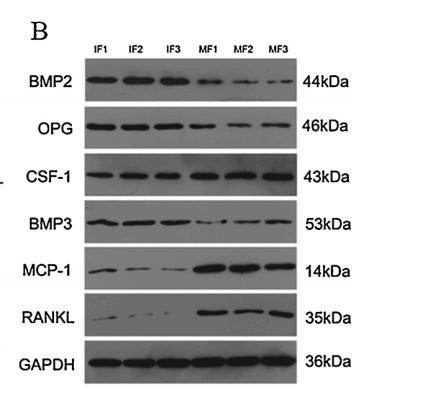BMP3 Antibody - #AF5153
| Product: | BMP3 Antibody |
| Catalog: | AF5153 |
| Description: | Rabbit polyclonal antibody to BMP3 |
| Application: | WB IHC IF/ICC |
| Reactivity: | Human, Mouse, Rat |
| Prediction: | Bovine, Sheep |
| Mol.Wt.: | 53 kDa; 53kD(Calculated). |
| Uniprot: | P12645 |
| RRID: | AB_2837639 |
Related Downloads
Protocols
Product Info
*The optimal dilutions should be determined by the end user.
*Tips:
WB: For western blot detection of denatured protein samples. IHC: For immunohistochemical detection of paraffin sections (IHC-p) or frozen sections (IHC-f) of tissue samples. IF/ICC: For immunofluorescence detection of cell samples. ELISA(peptide): For ELISA detection of antigenic peptide.
Cite Format: Affinity Biosciences Cat# AF5153, RRID:AB_2837639.
Fold/Unfold
BMP-3; BMP-3A; bmp3; BMP3_HUMAN; BMP3A; Bone morphogenetic protein 3 (osteogenic); Bone morphogenetic protein 3; Bone morphogenetic protein 3A; Osteogenin;
Immunogens
- P12645 BMP3_HUMAN:
- Protein BLAST With
- NCBI/
- ExPASy/
- Uniprot
MAGASRLLFLWLGCFCVSLAQGERPKPPFPELRKAVPGDRTAGGGPDSELQPQDKVSEHMLRLYDRYSTVQAARTPGSLEGGSQPWRPRLLREGNTVRSFRAAAAETLERKGLYIFNLTSLTKSENILSATLYFCIGELGNISLSCPVSGGCSHHAQRKHIQIDLSAWTLKFSRNQSQLLGHLSVDMAKSHRDIMSWLSKDITQLLRKAKENEEFLIGFNITSKGRQLPKRRLPFPEPYILVYANDAAISEPESVVSSLQGHRNFPTGTVPKWDSHIRAALSIERRKKRSTGVLLPLQNNELPGAEYQYKKDEVWEERKPYKTLQAQAPEKSKNKKKQRKGPHRKSQTLQFDEQTLKKARRKQWIEPRNCARRYLKVDFADIGWSEWIISPKSFDAYYCSGACQFPMPKSLKPSNHATIQSIVRAVGVVPGIPEPCCVPEKMSSLSILFFDENKNVVLKVYPNMTVESCACR
Predictions
Score>80(red) has high confidence and is suggested to be used for WB detection. *The prediction model is mainly based on the alignment of immunogen sequences, the results are for reference only, not as the basis of quality assurance.
High(score>80) Medium(80>score>50) Low(score<50) No confidence
PTMs - P12645 As Substrate
| Site | PTM Type | Enzyme | Source |
|---|---|---|---|
| S68 | O-Glycosylation | Uniprot | |
| T69 | O-Glycosylation | Uniprot | |
| T75 | O-Glycosylation | Uniprot | |
| S83 | O-Glycosylation | Uniprot | |
| T107 | Phosphorylation | Uniprot |
Research Backgrounds
Negatively regulates bone density. Antagonizes the ability of certain osteogenic BMPs to induce osteoprogenitor differentitation and ossification.
Secreted.
Expressed in adult and fetal cartilage.
Homodimer; disulfide-linked.
Belongs to the TGF-beta family.
References
Application: WB Species: Rat Sample: Incisor dental follicle (IF) cells and molar dental follicle (MF) cells
Restrictive clause
Affinity Biosciences tests all products strictly. Citations are provided as a resource for additional applications that have not been validated by Affinity Biosciences. Please choose the appropriate format for each application and consult Materials and Methods sections for additional details about the use of any product in these publications.
For Research Use Only.
Not for use in diagnostic or therapeutic procedures. Not for resale. Not for distribution without written consent. Affinity Biosciences will not be held responsible for patent infringement or other violations that may occur with the use of our products. Affinity Biosciences, Affinity Biosciences Logo and all other trademarks are the property of Affinity Biosciences LTD.





